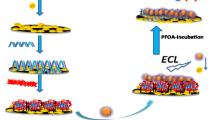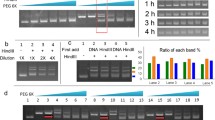Abstract
The plasmid DNA binding and cleavage activities with gold nanoparticles (Au-NPs) were investigated by the integrated tools of UV-vis spectroscopy, atomic force microscopy (AFM), and DNA electrophoresis. The results showed that the absorbance of Au-NPs decreased at 520 nm and a new absorption peak at 570 nm was found, as the DNA concentration increased, which indicated the particle aggregation. AFM experiments showed that DNA-induced particle aggregation originated from the strong interactions between DNA and Au-NPs, that is, the adsorption of DNA onto the Au-NPs surface would result in particle aggregation. After a short period of time, the Au-NPs were easier to aggregate in the presence of the higher concentration of DNA. At the early stage of incubation, the DNA double helix conformation was substantially changed by particles. The electrophoresis manifested the absorption and damage appeared on the native DNA molecules. With a longer treating time, the molecules were broken into fragments. The DNA damage was deemed to be a gradual process. The nonspecific interactions between DNA and Au-NPs resulted in the binding of DNA to the Au-NPs surface. Consequently, not only Au-NPs were aggregated but also DNA was damaged.
Similar content being viewed by others
References
Kanehara M, Sakurai J-i, Sugimura H. Room-temperature Size Evolution of Thiol-protected Gold Nanoparticles Assisted by Proton Acids and Halogen Anions[J]. Am. Chem. Soc., 2009, 131: 1 630–1 631
Hussain I, Graham S, Wang Z, et al. Size-controlled Synthesis of Near-monodisperse Gold Nanoparticles in the 1–4 nm Range Using Polymeric Stabilizers[J]. Am. Chem. Soc., 2005, 127: 16 398–16 399
Perrault S D and Chan W C W. Synthesis and Surface Modification of Highly Monodispersed, Spherical Gold Nanoparticles of 50–200 nm[J]. Am. Chem. Soc., 2009, 131: 17 042–17 043
De M, You C, Srivastava S. Biomimetic Interactions of Proteins with Functionalized Nanoparticles: a Thermodynamic Study[J]. Am. Chem. Soc., 2007, 129: 10 747–10 753
Daniel M C and Astruc D. Gold Nanoparticles: Assembly, Supramolecular Chemistry, Quantum-size-related Properties, and Applications Toward Biology, Catalysis, and Nanotechnology[J]. Chem. Rev., 2004, 104: 293–346
Zhao W, Brook M A and Li Y. Design of Gold Nanoparticle-based Colorimetric Biosensing Assays[J]. Chem. Bio. Chem., 2008, 9: 2 363–2 371
Baptista P, Pereira E, Eaton P. Gold Nanoparticles for the Development of Clinical Diagnosis Methods[J]. Anal. Bioanal. Chem., 2008, 391: 943–950
Shim S-Y, Lim D-K and Nam J-M. Ultrasensitive Optical Biodiagnostic Methods Using Metallic Nanoparticles[J]. Nanomedicine, 2008, 3: 215–232
Gourishanka A, Shukla S, Ganesh K N. Isothermal Titration Calorimetry Studies on the Binding of DNA Bases and PNA Base Monomers to Gold Nanoparticles[J]. J. Am. Chem. Soc., 2004, 126: 13 186–13 187
Memers L M, Stblom M, Zhang H. Thermal Desorption Behavior and Binding Properties of DNA Bases and Nucleosides on Gold[J]. Am. Chem. Soc., 2002, 124: 11 248–11 249
Jang N H. The Coordination Chemistry of DNA Nucleosides on Gold Nanoparticles as a Probe by SERS[J]. Bull. Korean. Chem. Soc., 2002, 23: 1 790–1 800
Storhoff J J, Elghanian R, Mirkin C A. Sequence-dependent Stability of DNA-modified Gold Nanoparticles[J]. Langmuir, 2002, 18: 6 666–6 670
Zhao W T, Thomas M H, Lee M H. Tunable Stabilization of Gold Nanoparticles in Aqueous Solutions by Mononucleotides[J]. Langmuir, 2007, 23: 7 143–7 147
Li H and Rothberg L. Colorimetric Detection of DNA Sequences Based on Electrostatic Interactions with Unmodified Gold Nanoparticles[J]. Proc. Natl. Acad. Sci. USA, 2004, 101: 14 036–14 039
Li H and Rothberg L. Label-free Colorimetric Detection of Specific Sequences in Genomic DNA Amplified by the Polymerase Chain Reaction[J]. Am. Chem. Soc., 2004, 126: 10 958–10 961
Cho K, Y L, Lee C H. Selective Aggregation Mechanism of Unmodified Gold Nanoparticles in Detection of Single Ucleotide Polymorphism[J]. Phys. Chem. C, 2008, 112: 8 629–8 633
Rho S, Kim S J, Lee S C. Colorimetric Detection of ssDNA in a Aolution[G]. Curr. Appl. Phys., 2009, 9: 534–537
Bhabra G, Sood A, Fisher B. Nanoparticles Can Cause DNA Damage Across a Cellular Barrier[J]. Nature Nanotechology, 2009, 4: 876–883
Peng L, Weiying Z, Xi L. Structural Basis for the Biological Effects of Pr(III) Ions: Alteration of Cell Membrane Permeability[J]. Biol. Trace Elem. Res., 2007, 120: 141–147
Kanjanawarut R and Su X. Colorimetric Detection of DNA Using Unmodified Metallic Nanoparticles and Peptide Nucleic Acid Probes[J]. Anal. Chem., 2009, 81: 6 122–6 129
Su X and Kanjanawarut R. Control of Metal Nanoparticles Aggregation and Dispersion by PNA and PNA-DNA Complexes, and Its Application for Colorimetric DNA Detection[J]. ACS Nano., 2009, 3: 2 751–2 759
Anas A, Akita H, Harashima H. Photosensitized Breakage and Damage of DNA by CdSe-ZnS Quantum Dots[J]. Phys Chem B, 2008, 112: 10 005–10 011
Author information
Authors and Affiliations
Corresponding author
Additional information
Funded by the Fundamental Research Funds for the Central Universities (No.2013-Ia-031)
Rights and permissions
About this article
Cite this article
Hu, S., Liu, P. & Hu, Y. Aggregation of gold nanoparticles and DNA damage by atomic force microscopy. J. Wuhan Univ. Technol.-Mat. Sci. Edit. 29, 180–184 (2014). https://doi.org/10.1007/s11595-014-0889-4
Received:
Accepted:
Published:
Issue Date:
DOI: https://doi.org/10.1007/s11595-014-0889-4




